
When it comes to taking notes, some people might think a few key phrases jotted down on a scrap piece of paper is good enough. But for me — an obsessive note-taker — that would never cut it.
I used to be a person who never really wrote anything down. I would rely on my memory to get me through school and work, and it always seemed to work out okay. But about two years ago, I realised that if I wanted to be more successful in life, I needed to start writing things down. And so, I began looking for ways to use notes for everything.
I used to be a person who never really wrote anything down. I would rely on my memory to get me through school and work, and it always seemed to work out okay. But about two years ago, I realised that if I wanted to be more successful in life, I needed to start writing things down. And so, I began looking for ways to use notes for everything.
From storing ideas to giving feedback to improving relationships, I’ve learned much about using notes to improve my life. This is a summary of what I’ve discovered along the way:
From the second I wake up in the morning, my mind is already racing with ideas and things I need to remember. I quickly grab my notebook and start jotting down whatever is on my mind before I forget.

I had the most exciting dream last night! I was hunting for enchanted food using dowsing rods in other worlds. I’m sure there’s a million-dollar storey idea in that somewhere. Before I forget, I quickly open my Obsidian Quick Notes iOS shortcut and begin jotting down any details.

I feel pretty good today, all things considered. I stayed up a little too late last night, so I’m not 100% this morning. But a quick check of my sleep cycle app (Rise) scolds me for my increasing sleep debt. Selecting an unhappy face, I noted down staying out too late again as the cause again.
Mornings are a great time to start fresh, and I used to think there was no better way to start the day than with a good doom scroll. However, I’ve since realised that there are much better ways to start the day.
A study cited by the Times estimates that we consume the equivalent of 174 full newspapers’ worth of content daily, five times higher than in 1986. But instead of empowering us, this deluge of information often overwhelms (and depresses) us.
If you’re interested in keeping up with the latest in news, politics, technology, etc. but don’t have the time to sift through all the noise, I have just the solution.
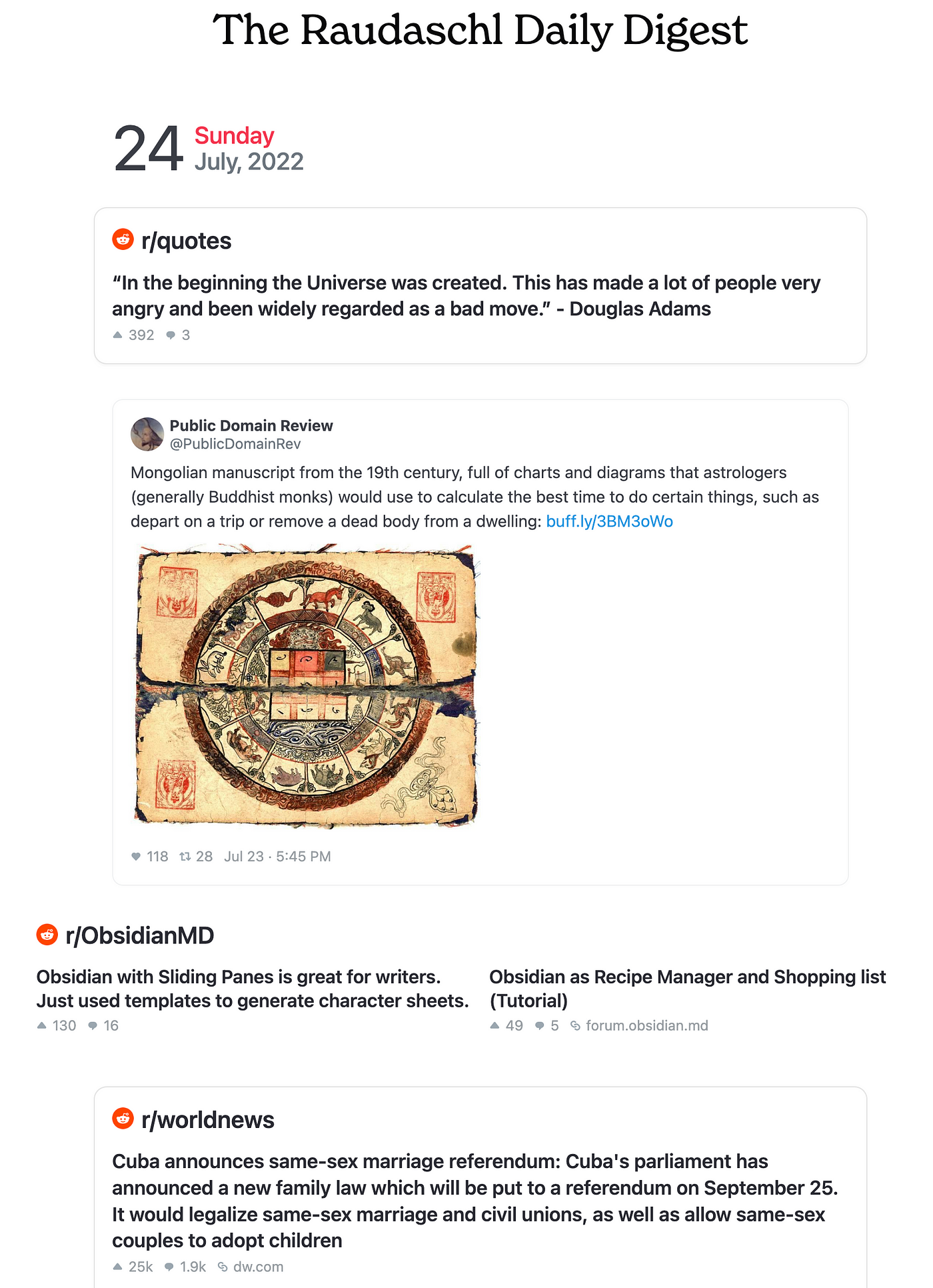
I have compiled the best Reddit threads, hacker news posts, Twitter lists, and RSS feeds into a daily email using an app called Mailbrew. This way, I can get my daily dose of news delivered right to my inbox, and I don’t have to waste time wading through the things I’m not interested in.
By condensing everything I value into two emails daily, I no longer feel the need to constantly be engaged. I can focus on other tasks and enjoy my downtime without worry.
Thanks to Mailbrew, I have learned to love information again.
I pull up my ‘read later’ app (I’m currently beta testing Readwise, but Instapaper, Pocket and Matter are also great) and begin scrolling through my saved articles.
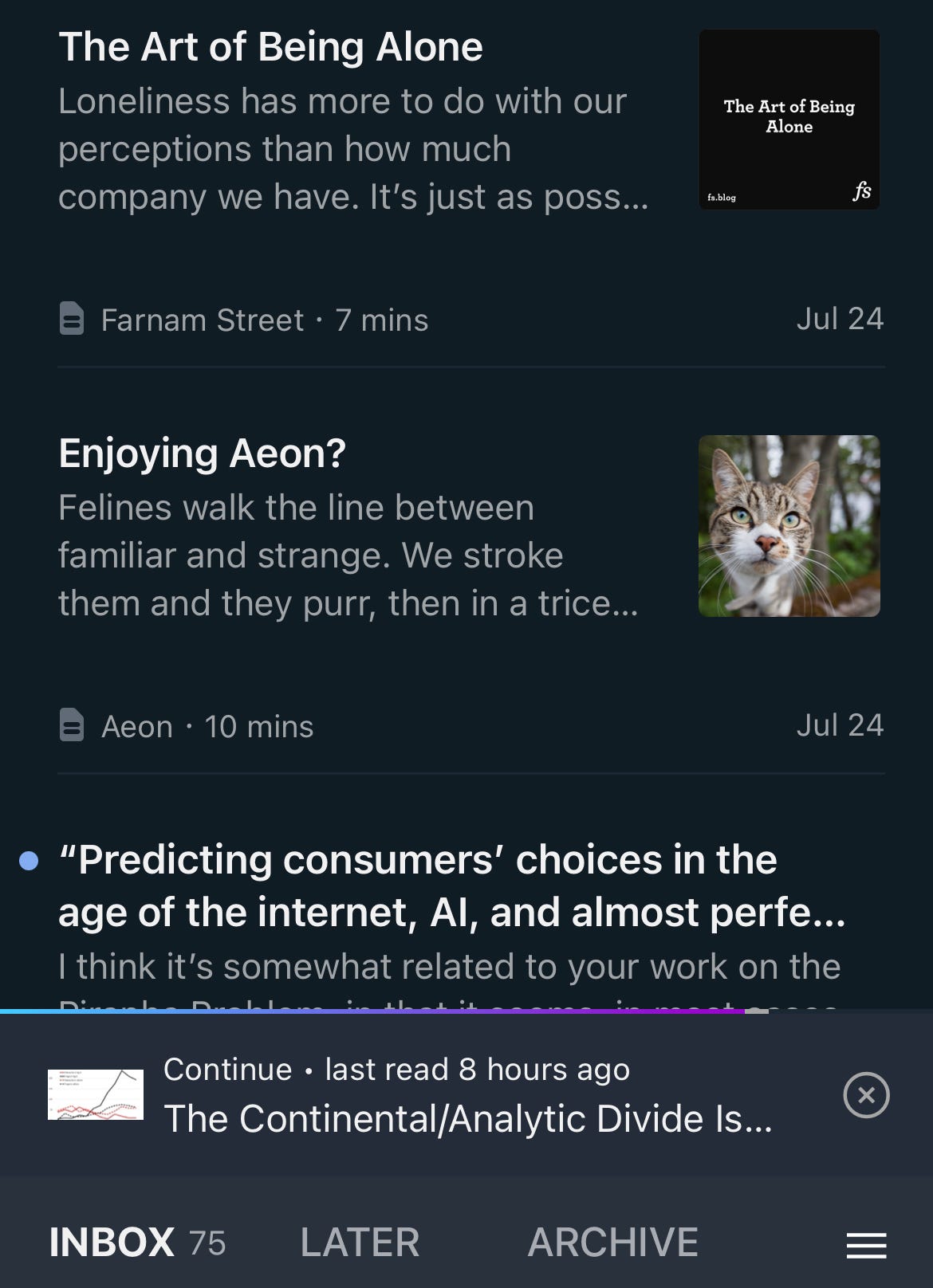
There are 30 more minutes before I get up, so I want to make the most of it. I found an article I had saved a few weeks ago and clicked on it.
The great thing about these apps is that they allow me to highlight and comment on the text I find interesting. Then all those highlights are automatically synced via Readwise into my personal knowledge system, Obsidian.
I find that when we read intending to find something that resonates, the experience becomes more intentional. Our minds are always on the hunt for insights, and we can’t help but resonate with content on a deeper level.
Even though it’s exhausting, once the insights are saved, it feels worth it and becomes part of our working memory over time. As I will describe later, this allows me to connect the dots between different pieces of information more efficiently and clearly see the big picture.
As Tiago Forte writes in his excellent book, ‘Building a Second Brain’, “every bit of energy we spend straining to recall things is energy not spent doing the thinking that only humans can do: inventing new things, crafting stories, recognising patterns, following our intuition, collaborating with others, investigating new subjects, making plans, testing theories”.
The act of brushing teeth is necessary both for the teeth and for the brain. That’s why I’ll do it whenever I wake up.
Richard Feynman, the theoretical physicist and all-around genius, once stated, “You have to keep a dozen of your favorite problems constantly present in your mind, although by and large they will lay in a dormant state. Every time you hear or read a new trick or a new result, test it against each of your twelve problems to see whether it helps. Every once in a while there will be a hit, and people will say, “How did he do it? He must be a genius!”
Taking inspiration, with each brush of my molars, I have time to ponder the things I’ve read, the notes I’ve taken and life’s biggest problems:
- Needing to finish writing this article
- Renovating my bathroom
- Why does my mother not think I speak with her enough
- Settling a dispute between two colleagues
- A tough coding problem
- Where did all my money go?
- Why has my partner banned me from saying ‘Second Brain’
- And what is even the point of anything really?
I’m staring in the mirror, half-awake and groggy. But somewhere between moments of toothpaste squeezing and flossing, I hope my mind miraculously sees the bigger picture and provides wise solutions for all my problems.
Sometimes I get lucky, but more often than not, I’m left with pearly whites and a mild headache.
It takes a special kind of person to hit the gym hours after waking, and it’s awesome when that person is me.
I know that taking time away from work is necessary, even though it’s really annoying. Like a fart in a room, hunting for knowledge and taking notes quickly fills up all available space.
One of the benefits of, say, going to a yoga class or church is that it’s impossible to work while you’re there. Presence, I find, is better protected by obligations than intentions.
“We must not fear daylight just because it almost always illuminates a miserable world — Rene Margritte” — Belgian surrealist
Walking to work is one of my favourite things about living in a city like London. There’s something about the hustle and bustle of the city that I just love.
Many people claim they do their best thinking while walking. A Stanford study from 2014 found that walking indeed boosts creative output by an average of 60%. Walking has also been found to promote new connections between brain cells and stave off the usual withering of brain tissue.
I find that whilst walking, I enter a diffuse mode of thinking best by practising the art of noticing things along the way. I learned to appreciate this after reading Rob Walker’s fantastic book, The Art of Noticing.
I take in the small details; the way the sun is shining through the trees, the sound of the leaves crunching under my feet, the feel of the fresh air on my skin. Without these small details, life would be a dull, mundane existence. But with them, I am constantly surrounded by beauty and wonder.
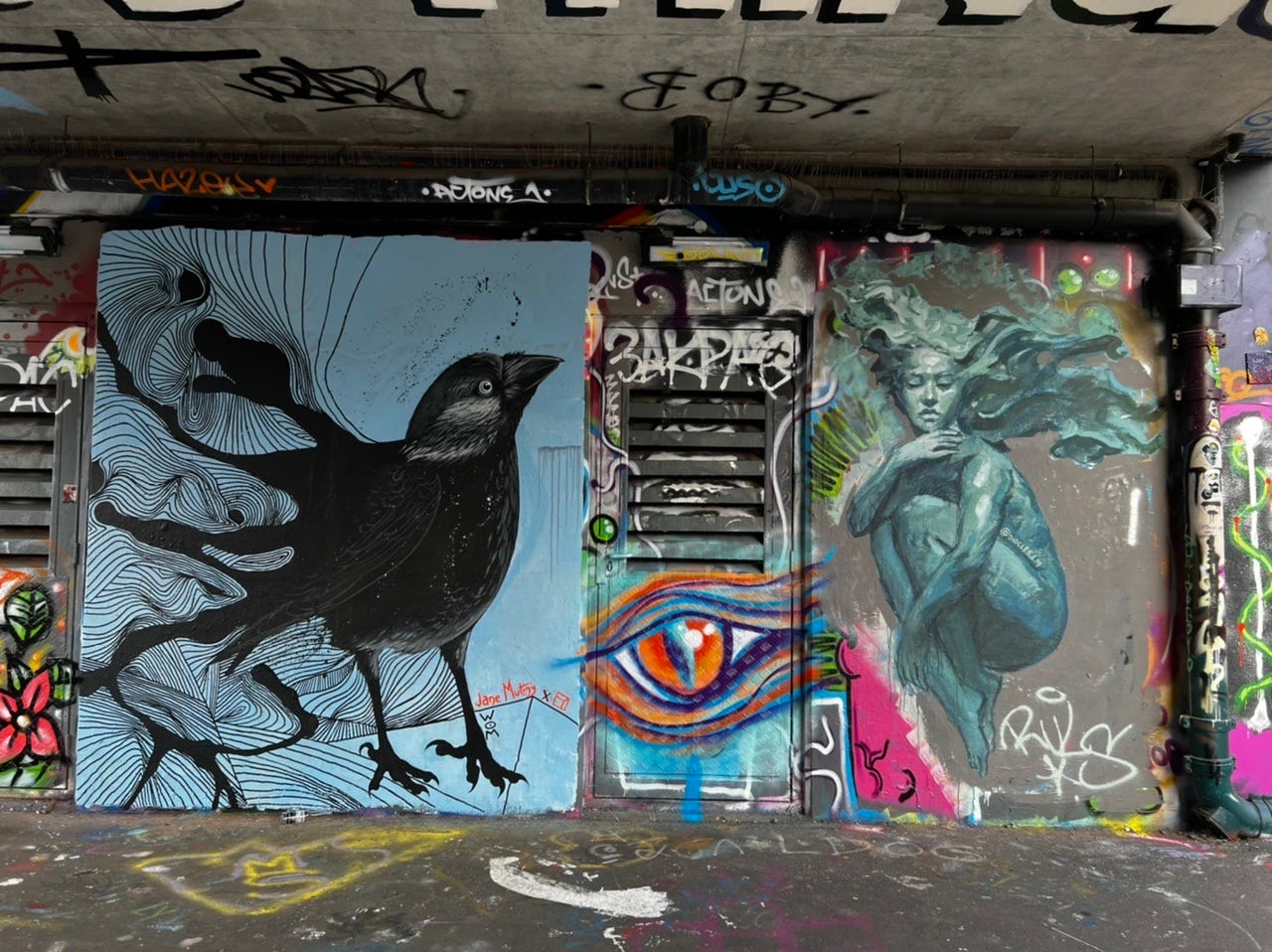
Luckily my area of London, Shoreditch, is well known for its street art, so paying attention to walls, floors and even drains is quite entertaining.
I’ve made it a habit to use Apple Notes to take pictures of any artwork, posters, stickers, illustrations and sculptures that capture my attention. Occasionally, I’ll ask myself, “What must have been true in the world for this artwork to exist?” and write a few associated words.
We can indeed find interesting things anywhere if we’re open to it. The next time you’re bored, instead of reaching for your phone, look around you and see what you can find that’s impressive, surprising, or just plain fun.
From noticing flowers to drain covers, you might be surprised at what you discover.
In a study that lasted 10 years, the US Military found that to be most productive, we should drink two cups of weak coffee right before starting our shift. So, coffee in hand, it’s time to start the day.
At work, I have fully embraced the “Notes Renaissance” and have a separate work Obsidian vault reserved only for job-related activities.
I have been using Obsidian for a few months now to help me organise my thoughts, feelings, and tasks for the day using a custom daily note template. I have found that it is an excellent tool for helping me to focus on what is essential and keeping track of progress. There is one rule, however: never write anything about a person you wouldn’t say to that person directly.
My daily template looks something like this:
Start of Day Reflections 🪞
Stress: (Score 1-5)
Joy: (Score 1-5)
Notes: Thankful For 🙏
* List things hereTop of mind (Concerns) 🔥
* List things i'm most worried aboutWhat would make today awesome 🌟
* List our my idea outcomes for the dayWorklog
* List titles of meetings and tasks for the dayEnd of Day Reflections 🪞
Stress: (Score 1-5)
Joy: (Score 1-5)
Notes:
I recently read an article by the academic Ralph Waldo Emerson that by keeping such reflection diaries, you remind yourself to set happiness as a priority for yourself. This resonated with me, and I have been working on incorporating this into my daily routine.
To begin with, I am asked to rate my joy and stress on a scale of 1–5 and then to write down the things I appreciate about our team. I am then asked to list my top concerns and what I think will make this day memorable.
When it comes to tackling our never-ending to-do lists, we could all afford to be a little more proactive. Rather than just writing out a list of everything we need to do and then hoping for the best, I find it far more effective to take a step back and list all the potential obstacles I might face.
One study found that people could triple their daily progress on their goals using an obstacle-focused journaling technique.
There were three steps involved:
• Step one was to write down a few goals they wanted to achieve throughout the day ahead.
• Step two was to write down any obstacles that might come up which could potentially derail their success.
• Step three was to describe what they’d do to overcome those obstacles if and when they came up.
The people who took the extra time to plan for failure were up to three times more likely to achieve their daily goals, and, not insignificantly, they were substantially happier at the end of each day!
Here’s an example of how such a journal template could look:
🎯 Goal — finish book proposal
✋ Obstacle — I might get tempted to watch reruns of The Office
🚀 solution — throw the TV remote on the roof
Once I can identify my hurdles, I feel more enabled to develop a plan for how to overcome them.
Next, I’ll review the notes from the previous day. This helps me quickly get oriented by reminding me of things like, “What’s this person telling me? “”What should I remember about this topic?” or “What is on my plate at the moment?”
To finish off, I will list the headlines of the meetings and tasks for the day. During the day, I will add notes and summaries under each header to describe what happened, what worked well, and what tasks remain.
This will help me to remember what happened during the day and reflect on what I have accomplished.
“We learn from reflection on experience, not from experience itself.” — John Dewey, Philosopher
I love meeting new people and hearing about their vocations, but I also like to do my research beforehand.
When meeting someone new, I always check my Obsidian “vault” to see if we have any connections. This includes checking to see if we have spoken before, if I’ve seen their work, or if I’ve attended any of their presentations. It’s a great way to break the ice when you can mention such connections during an introduction.
Almost as important as greeting people, however, is giving them an excellent presentation.
I used to believe that you needed to have everything memorised to be a great presenter. I would practice and practice until I had my presentation down pat. But in some cases, I’ve found that a more organic approach works better for me.
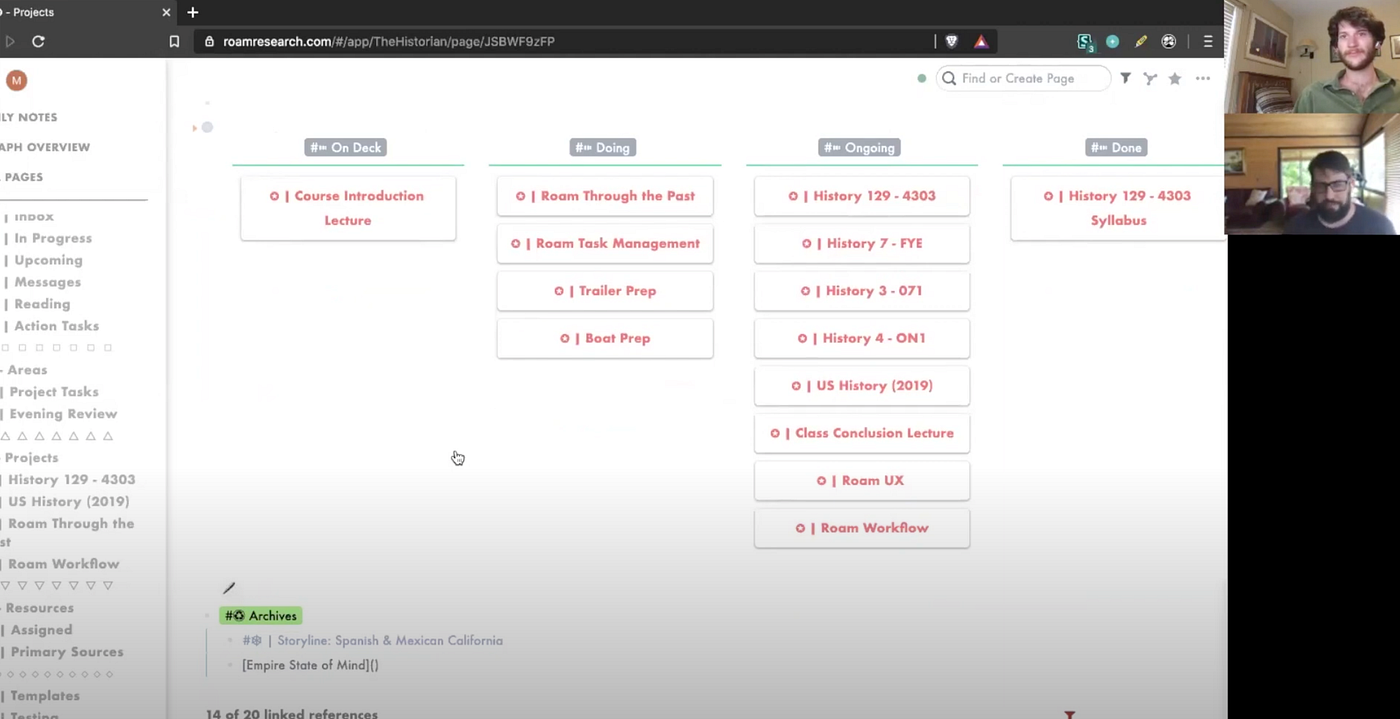
Now I bring my notes with me when I’m leading a meeting and sometimes use them instead of slides. This approach was inspired by Mark Robertson, a historian who uses Roam graphs to support his teaching methods. Mark uses tagging to add dates and other metadata to historical phenomena that he then navigates in real-time while presenting lectures to his students. As a result, Mark can quickly pivot around his historical database to answer his students’ questions.
In addition to helping present, notes are a great way to collaborate with a group in real-time. I’ve witnessed how much more engaging it is when people can see their interactions become text and bullet points on the screen. These notes also help to keep everyone on the same page, as everyone can refer back to them later.
This helps us keep track of our decisions and lets us know where we need to improve. Having a meeting summary also helps build trust and appreciation among colleagues.
In the information age, we are constantly bombarded with information from various sources. According to a 2011 study, we consume about five times as much data per day as we would have just a quarter century earlier.
In fact, according to the New York Times, the average person’s daily consumption of information now adds up to a remarkable 34 gigabytes.
Before I started taking notes, I forgot most of the things I read. By writing down and storing the information acquired over a work day, knowledge can now be remembered and applied when needed.
In order to create a meaningful and engaging note collection, I must be selective about what emails, presentations, conversations or wiki pages I allow in. I need to focus on the details that make eyes blink, and hearts skip a beat. This way, I can create a collection that captures what truly resonates with me.
To achieve this, I ask myself a few questions before adding anything:
- Does It Inspire Me?
- Is It Useful? — Sometimes, you come across a piece of information that isn’t necessarily inspiring, but you know it might come in handy in the future — a statistic, a reference, a research finding, or a helpful diagram.
- Is It Personal? — Like the age-old practice of journaling or keeping a diary, we can use notetaking to document our lives and better understand how we became who we are.
- Is It Surprising? — Information theorist Claude Shannon, whose discoveries paved the way for modern technology, had a simple definition for “information”: that which surprises you. If you’re not surprised, then you already knew it at some level, so why take note of it?
Once captured, we need a place to store stuff so it’s easy to rediscover. I personally use the PARA system, which encourages me to place notes into one of four folders:
- Projects (things I’m working on)
- Areas of Responsibility (things I’m responsible for)
- Resources (things I’m interested in)
- Archives (things I’m afraid to throw away
I find it helpful to have such a basic system for storing information, even though the search is usually adequate for finding old notes. Something about it seems to calm my mind.
Maybe it’s the feeling of knowing where everything is, or perhaps the act of organising itself feels satisfying. Whatever the reason, I know that having a system helps me feel more relaxed and in control.
As knowledge management experts Chris Collison and Geoff Parcell once said: “You can’t manage knowledge — nobody can. What you can do is to manage the environment in which knowledge can be created, discovered, captured, shared, distilled, validated, transferred, adopted, adapted, and applied.”
What if I told you there was a way to get better at something without putting in any additional work? You might not believe me, but it’s true.
The best way to become better at something is to deliberately re-expose yourself to notes and ideas you’ve previously captured, and no better time exists for this than Lunchtime.
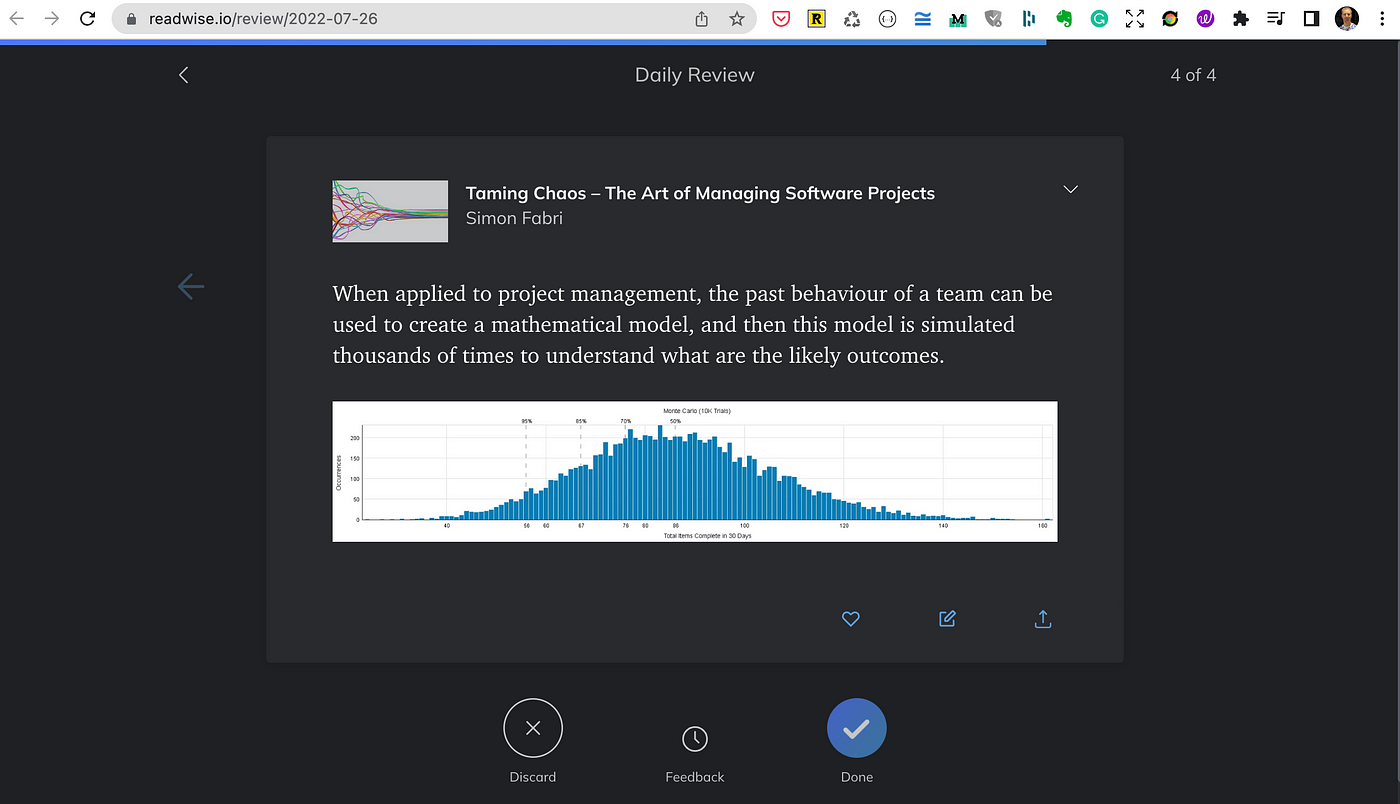
Just reading something once isn’t enough to make it stick in our minds. But thanks to Readwise, I can send myself an email daily with 5 random notes to review from my Kindle and Read Later apps.
Hermann Ebbinghaus (1850–1909), a German psychologist and pioneer of quantitative memory research, found that spaced repetition is an effective way to improve long-term recall. Recent research appears to support these claims.
For me, however, being exposed to old information is most satisfying when I can apply it to a current problem or when it inspires a serendipitous idea or evokes a fascinating memory. When I read about historical events, for example, I often think about how they relate to current events. It’s fascinating to see how the past can inform the present and vice versa.
Of course, lunchtimes are also for eating, but there is no better meal than one comprised of “food for thought.”
“Chance favors the prepared mind. “– Louis Pasteur
Losing important work documents can feel like an afternoon wasted. According to a recent Microsoft study, the average person spends about one-fifth of their workday looking for the information they need to do their jobs.
The International Data Corporation report also found that 26% of a typical knowledge worker’s day is spent looking for and consolidating information spread across a variety of systems. That’s the equivalent of a whole work week each month! Imagine if we could get that time back.
In the BBC’s adaptation of Sherlock Holmes, Sherlock builds a fabled mind palace — an imaginary castle to stash his clues and concepts for later recall. With knowledge management apps, you can have your own virtual mind palace to access anytime, anywhere.
This eliminates distractions and allows me to be more productive. I can quickly find the necessary information without spending time sifting through irrelevant data.
For example, when starting a new strategy document, I can immediately use keywords and tags to search my vault for relevant notes, conversations, old presentations and templates to get me started. No looking for files in the download folder, no email hunting and no wiki page safari required.
Everything can be easily pulled into a single space, and I can start making lists of important information, people, and missing information.
“It is in the power of remembering that the self’s ultimate freedom consists. I am free because I remember.” — Abhinavagupta, tenth-century Kashmiri philosopher and mystic.
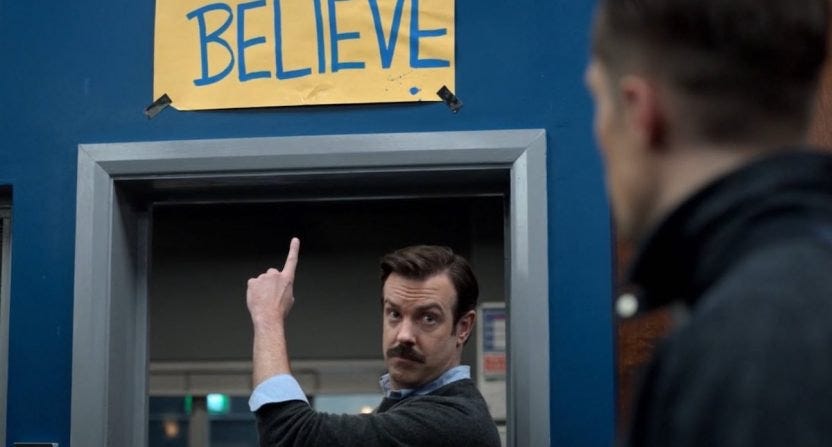
In the words of fictional football coach Ted Lasso: “For me, success is not about the wins and losses. It’s about helping these young fellas be the best versions of themselves on and off the field.”
Hitting quarterly targets and maximising productivity is essential, but we should also focus on helping our teams and organisations become their best version.
When a colleague asks for feedback like 360 performance reviews, I want to give real examples of what they did, what impressed me, and what I think they can improve.
This is where the daily template I mentioned early comes in handy. Having a practice of keeping a daily diary and writing down appreciations has helped me out a lot.
Not only am I able to provide timely feedback or praise, but I’m also building up a portfolio of accomplishments for each person I know. This is a great way to keep track of all the good things in my life and be more gracious towards the people around me. If you don’t show up when I do a search for your name, well, that’s quite telling in itself.
Either way, notes help turn this usually grinding chore into a piece of genuine personal feedback I’m proud to give my colleagues.
“Too many people bring the best of themselves to work and take the leftovers home” — Esther Perel, Psychologist
As the work day ends, I grade my stress and joy again, as well as make notes about anything interesting that happened.
Besides helping me decompress and disconnect from work, it reminds me that my biggest challenges aren’t as bad as they seem. Almost all problems can be broken down and dealt with one day at a time.
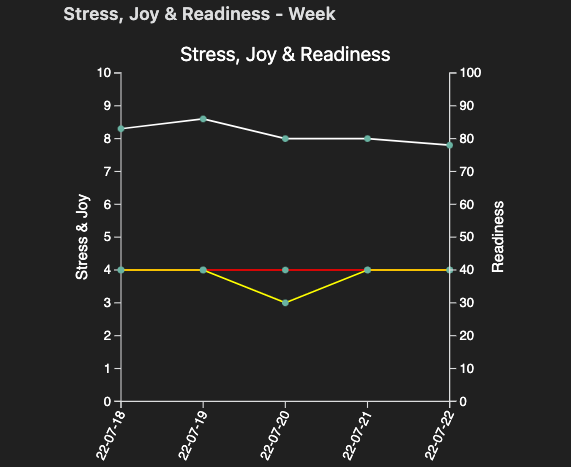
At the end of each week, I use the Obsidian Tracker plugin to visualise my mood and writing productivity during the week. I then review the daily notes from each day and make an end-of-week summary. This is super useful for Monday mornings and especially after holidays for getting things off on the right foot.
I also find that reviewing my notes every month helps me stay on top of my work and better understand the big picture. This makes writing quarterly, mid and end-of-year reviews much more manageable. Having a clear understanding of the work I’ve done over the past month helps me identify areas of improvement and track my progress.
Now, I can turn work “off” and relax, knowing I have a trusted system keeping track of all the details.
“Conversation lets you be an artist every time you open your mouth — or shut it.” — Robert Louis Stevenson
In many ways, being productive is easy, but as knowledge management expert Larry Prusak says, “If you have one dollar to invest in knowledge management, put one cent into information management and 99 cents into human interaction.”
Recently, I’ve neglected my friendship network, and the pandemic certainly hasn’t helped. The good news is that I have been inspired to use my notes to create my own CRM system to improve the situation. Following venture capitalist Peter Boyce’s example, I am using Airtable to help keep track of all my relationships.
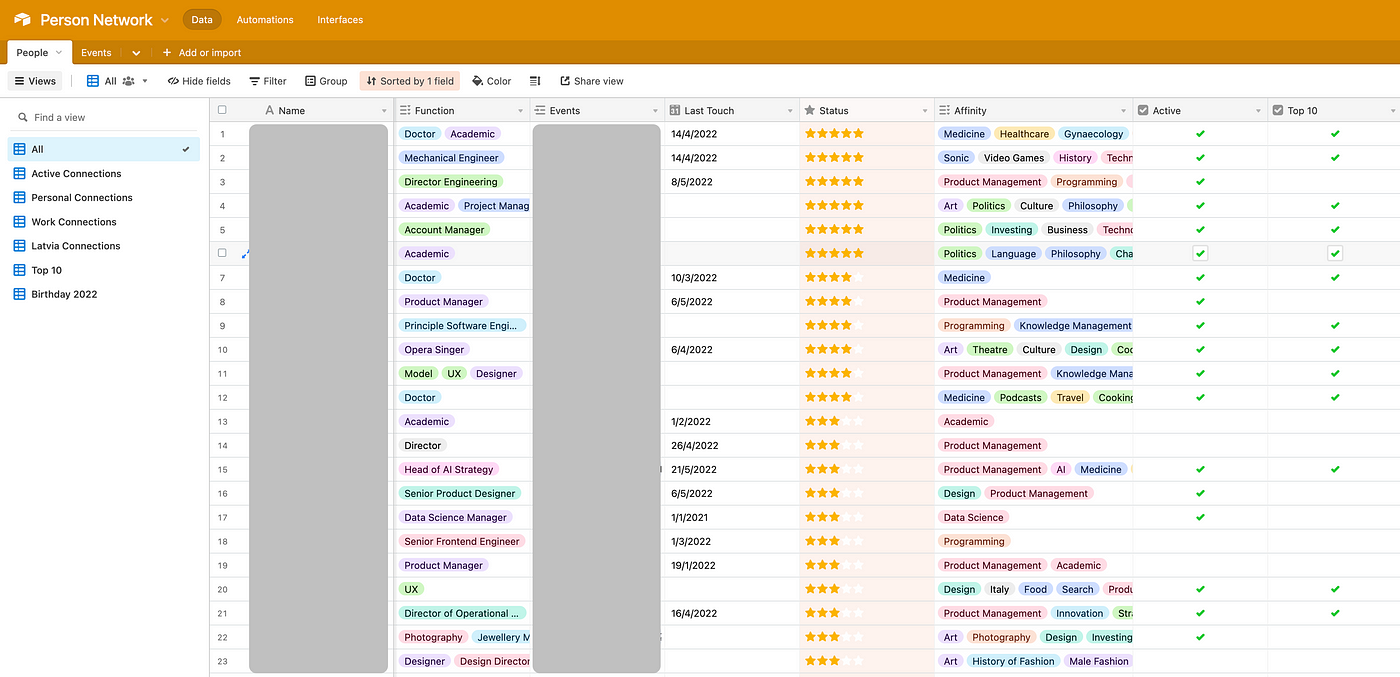
I accomplish this by listing all the people I know in a spreadsheet and recording their attributes:
- ‘Circle’ is how I record what network I was a part of when I got to know someone. Was it through university? Through work? Personal friendship?
- ‘Functional’ is how I keep a record of what work people do.
- ‘Status’ refers to whether I’ve done something to engage this person recently.
- ‘Affinity’ is where I record whatever someone might be into. If they’re into investment, say, or fashion, or if they’re obsessed with kimchi, I’ll put that here.
- ‘Last touch’ is a record of the last time we made contact.
- ‘Active’ — do I consider my current relationship with them active?
- ‘Geo’ shows where they’re based.
- Finally, under ‘Mutual’, I record the acquaintances and connections I have in common with someone — it’s all part of seeing how networks overlap and complement each other.
I find it helpful to track how often I have contacted someone, the events we have attended, and what makes our relationship unique. Maintaining and growing friendships is extremely important to me so that I can always be helpful to those around me.
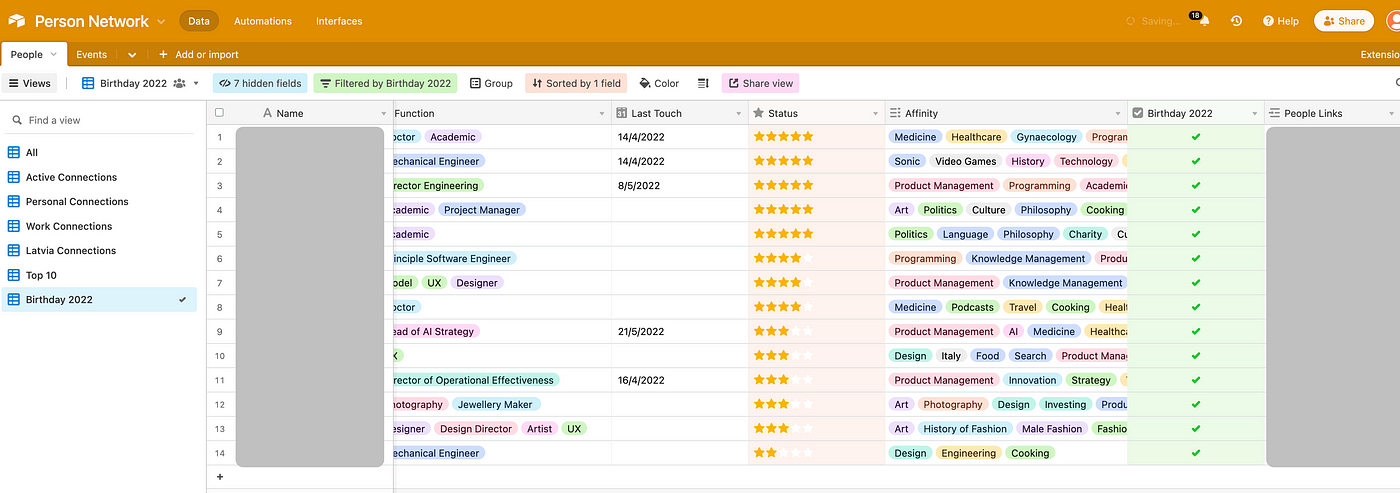
For my birthday, I even used this system to make sure everyone who attended could connect with at least one fantastic person. It was a smashing success, but I’ll admit that the alcohol may have done most of the work for me.
I’m constantly trying to find ways to connect people to my journey so that we can share information, energy and resources. I think it’s essential to have a robust support system of friends and loved ones to rely on, especially during tough times.
“Those who don’t build must burn” — Fahrenheit 451
After a long day, I enjoy nothing more than coming home and sitting at my computer to start a new article. I have so much creativity inside me that I could just burst. Sharing everything I’ve been fascinated by with others is one of the best forms of therapy I have.
Similar to how Taylor Swift uses notes to support her creative songwriting process, I use my notes to draw inspiration for new and existing projects.
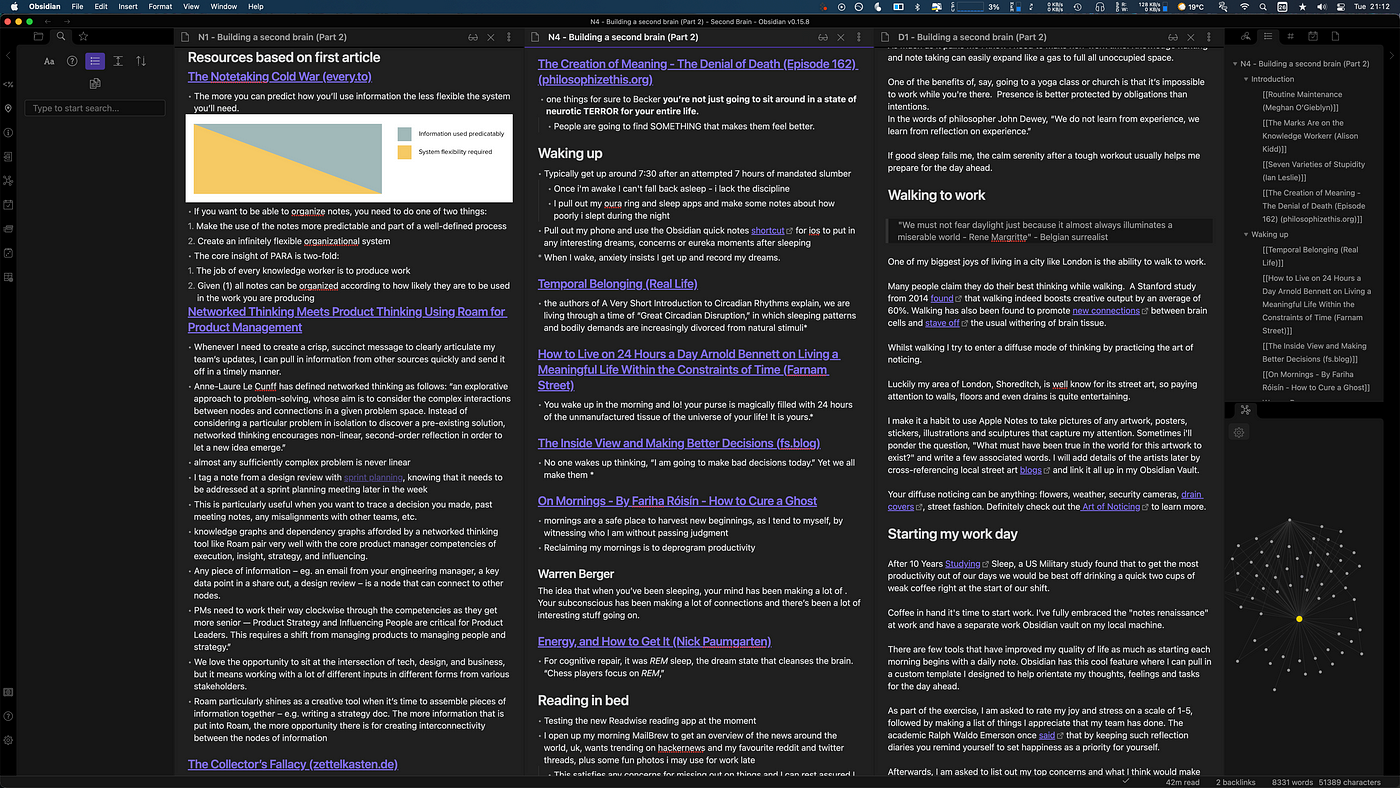
To start, I take the time to sit down and think about what I want to write about. Once I have a topic in mind, I create a blank page and start looking through my notes for any relevant titles that could form the basis of my article. As I open each note, I reread the content and copy in the most pertinent or interesting paragraphs.
This process helps me gather ideas and material for my writing and refresh my memory on topics I may not have thought about in a while.
I group my ideas into similar categories so I can start to see what direction I want to take in my writing. Once the paragraphs are grouped by theme, I examine everything again to determine what looks intriguing. Now I’m ready to start my first draft, occasionally referencing my original list of notes if I run into writer’s block.
When working on long-term projects, I’ve found that diaries are essential to keep track of all the thoughts, theories, and resources. Having a dedicated space to write down everything, I can keep my ideas organised and return to them quickly when needed.
This way, I ensure that no good ideas get left behind. Eventually, all these long-term projects will be ready for release, and I will have leveraged the beautiful experiences and knowledge I’ve collected in my note vault over the years.
“Creativity is just connecting things” — Steve Jobs
“Even when alternative views are clearly wrong, being exposed to them still expands our creative potential. In a way, the power of dissent is the power of surprise” — Jonah Lehrer, Author
One of the best ways to foster creativity and a healthier mental model is to expose myself to unfamiliar perspectives.
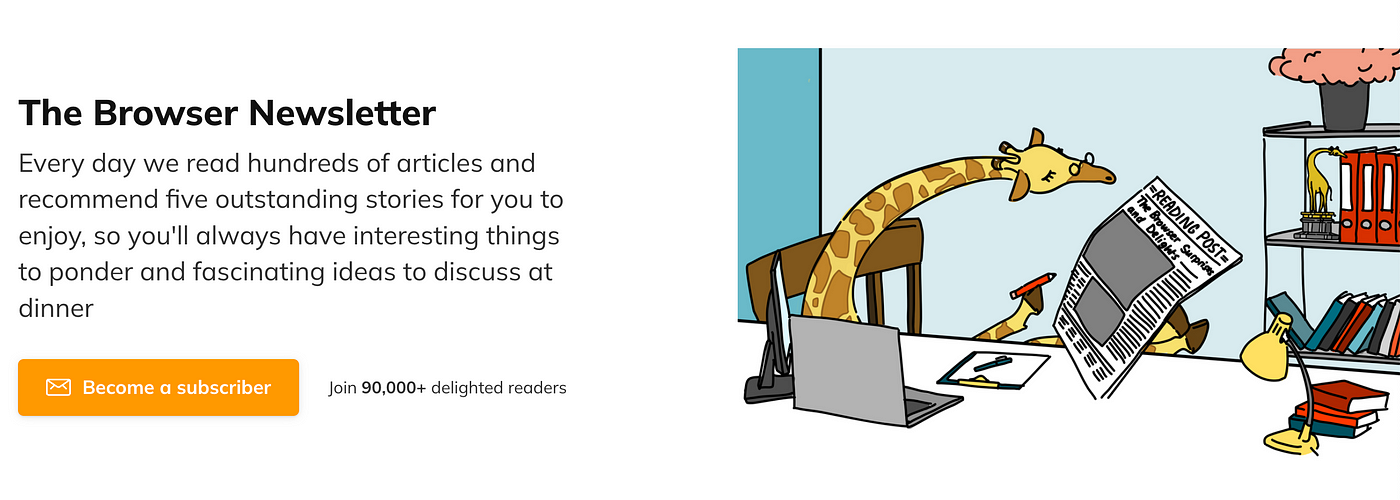
Every evening, I look forward to receiving an email from The Browser, whose editors curate some of the best online writing.
The magazine’s editors have carefully chosen stories from various fields — art, history, politics, theatre, technology, philosophy, etc., so I get a unique perspective on the world.
After adding the most interesting articles to my read later app, I settle in for another cosy reading and highlighting session.
“Never go to sleep without a request to your subconscious.” — Thomas Edison
Soviet psychologist Bluma Zeigarnik found a quirk of the human mind: When a task is unfinished, we can’t seem to stop thinking about it. If you’ve found yourself in bed at 2 am with your brain screaming at you about that thing you didn’t do, that’s a Zeigarnik moment.
In 2011, psychologists E. J. Masicampo and Roy Baumeister demonstrated the Zeigarnik effect on volunteers by giving them a task and not letting them complete it. It lingered in their minds and interfered with their ability to do other work.
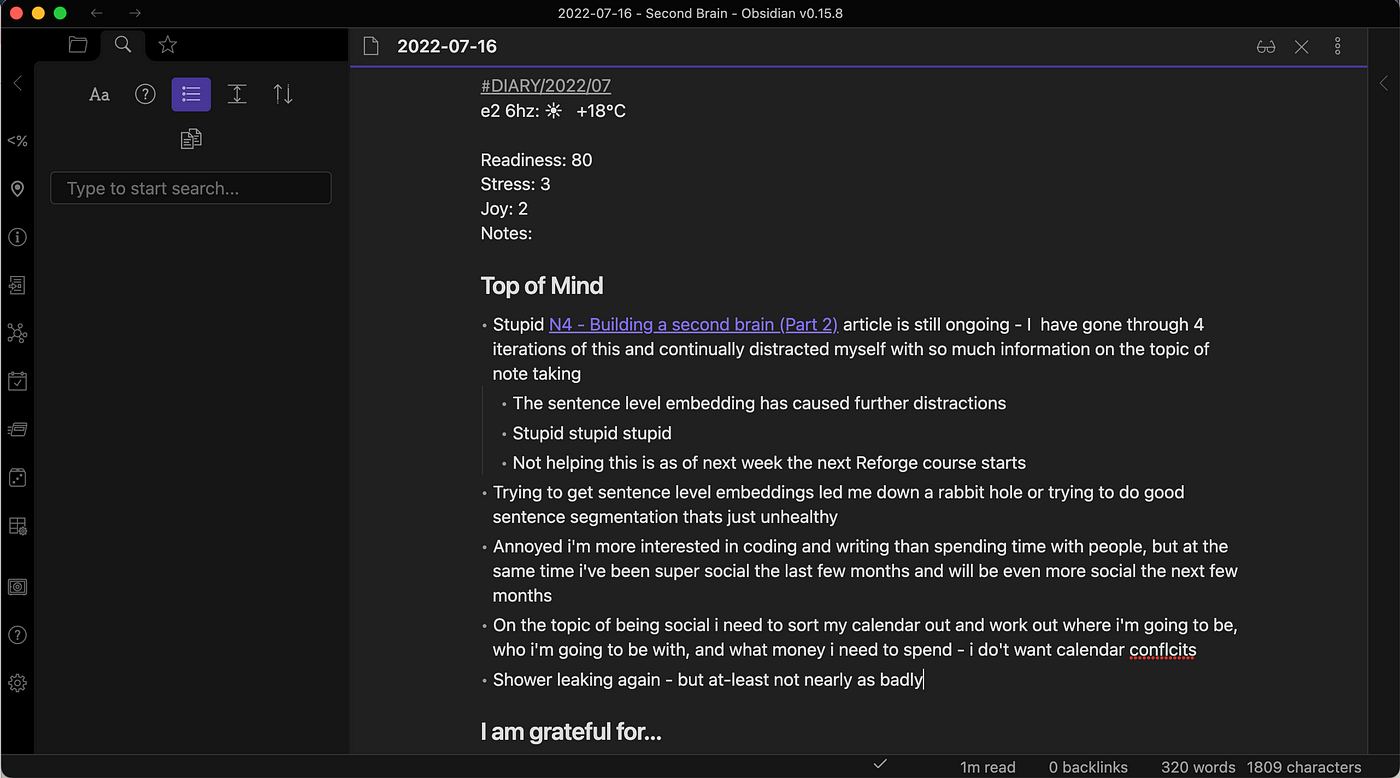
A great life hack I’ve learned is that I could cognitively offload most things by simply writing them down. Usually, I do this by journaling before bed, making a schedule, or creating a to-do list for the day ahead. This way, I can clear my mind of everything I need to do and focus on enjoying my free time or getting a good night’s sleep.
I have a lot on my mind before bed, so writing has allowed me to fall asleep more easily. I don’t have to worry about forgetting what’s on my mind because I can just write it down and fall asleep more easily.